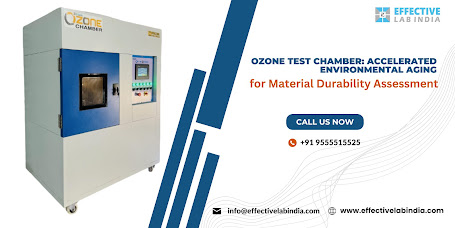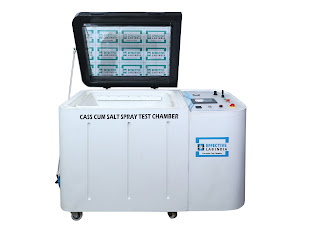Ozone Test Chamber: Accelerated Environmental Aging for Material Durability Assessment
To examine the effects of ozone exposure on different materials, goods, or components, a controlled environment known as an ozone test chamber is utilised. Degradation, discolouration, and other undesired alterations can occur in materials when exposed to ozone (O3), a reactive gas consisting of three oxygen atoms. As materials in the automotive, aerospace, electronics, and packaging sectors may be exposed to ozone at some point in their lives, ozone testing is essential in these sectors.
Scientists and engineers can replicate and expedite the consequences of ozone exposure in a controlled environment by using the test chamber. System controls for temperature, humidity, and ozone concentration are usually present in these chambers. Experiments with different time intervals can be used to evaluate the materials' impacts of both rapid and long-term ageing.
Understanding Ozone Impact: Testing Materials in a Controlled Chamber Environment
An Ozone Chamber is an instrument which is used for the resistance of products against ozone exposure. It tests the condition of products after simulating ozone-rich conditions. Moreover, several manufacturers need to understand the response of ozone layers on their products. It is crucial for the electronics, automotive and aerospace industries.
Hence, ozone ageing is done with the help of an Ozone Aging Test Chamber.
The following are the primary goals of ozone testing in a controlled chamber:
Material Durability: Determine how well-suited various materials are to long-term exposure to ozone.
Evaluate how ozone affects a product's performance and dependability, particularly if it is used outside or in an area with a lot of ozone.
Quality Control: Verify that products and materials adhere to ozone resistance criteria and regulations as set by the industry.
Research and Development: Get knowledge about how materials behave when exposed to ozone, as this knowledge can help create new materials with enhanced ozone resistance.
Environmental Simulation: Recreate real-world scenarios, such as outdoor settings or regions with high ozone pollution levels, where materials may be subjected to ozone.
What is an ozone chamber used for?
An ozone test chamber can be used to test ozone exposure’s effects on various products including plastic and rubber. Rubber products can undergo rapid testing in this controlled environment, which replicates real-world scenarios. Experts and manufacturers can assess the material's resistance to degradation in this chamber by exposing rubber samples to varying temperatures, humidity levels, and ozone concentrations. This ensures the creation of durable and dependable rubber goods suitable for a range of sectors. Ozone chamber for rubber testing is used for testing the effects of ozone on rubber products.
It has wide uses in polymer, plastic and electronic industries for checking the performance of products in practice conditions.
Hence, it is useful for determining the durability of several products.
How does the ozone test chamber work?
An effective ozone generator is installed in this chamber for the production of ozone gas. Moreover, a volume of processed air is produced in this chamber. It is used for assessing the ozone effects in several products.
Users can test the ozone ageing on their materials by:
- Expose the test specimens into the chamber.
- One thing you should note is to maintain the constant ozone concentration of the specimen.
- Set the temperature according to a predetermined time.
- After the set time, check the sample and look for surface cracks.
- Also, look for the degrees to which the properties of a product change.
What is the principle of the ozone test?
The ozone test’s basic idea is to subject items to regulated ozone concentrations in a testing facility. Over time, some materials may experience deterioration and damage due to ozone, a reactive form of oxygen. Manufacturers can evaluate a material’s resistance to ozone-induced impacts such as discolouration, degradation, and cracking by exposing it to ozone. The test assists in making sure that goods can endure exposure to ozone and keep their quality over time. It’s a means of assessing a material’s resilience in ozone-rich environments.
What are the methods of ozone testing?
Few methods are commonly used for ozone ageing testing. The most commonly used method is using the ozone test chamber method. In this method, the material to be tested is placed into the chamber and exposed to controlled ozone levels. The other method of ozone testing is the ozone-UV method. In this method, UV rays combine with ozone exposure to simulate outdoor conditions.
Moreover, there is another method known as the dynamic ozone method. In this method, the material is subjected to cyclic exposure to ozone and air. It mimics the fluctuating ozone levels in real-world environments.
All of these methods help in assessing the effects of ozone on materials and enhancing their durability.
Source URL: What is an ozone test chamber?




Comments
Post a Comment